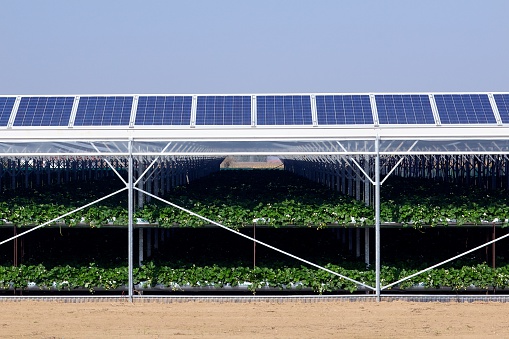The combination of photovoltaic panels and crops is a trend. An agrovoltaic installation allows land sharing.
Agrovoltaic energy
Firstly, agrovoltaic energy is born from the symbiosis of wind and photovoltaic farms. It is expected to be one of the main weapons against climate change. Shade and low water consumption make these systems an efficient form of cultivation.
Secondly, with years of research, solar panels are being used that take the dew from the environment. This water is condensed on the panels; and drains down to fall below them, where its shadow is located.
Thirdly, this discovered “virtuous cycle” generates an extraordinary microclimate, which supports the development of vegetation in the environment under the solar panels. Also, the shading of the photovoltaic panels reduces the drought stress of the plants, generates higher food production and reduces the thermal stress of the photovoltaic panels.
We recommend you to read: MEXICO IS THE LEADER IN THE ANNUAL INSTALLATION OF SOLAR PROCESS HEATING SYSTEMS WORLDWIDE.
Agricultural land productivity
Moreover, agrovoltaic systems have been proven to increase overall land productivity by 35 to 73 percent. The innovations of this model encourage coexistence and interaction, increase the value of the land, and positively support the local communities where it is implemented. It also favors nature conservation and helps maintain ecosystems.
With agrovoltaic, the potential for solar PV is greatest on farmland, a study by Oregon State University confirms. The report concludes that if less than 1% of agricultural land were converted to solar panels, it would be enough to meet the world’s demand for electricity.
We recommend: Toyota and NREL will develop MW-scale fuel cell systems.
Agrovoltaic applications
Agrovoltaics has different applications depending on the environment and the intended use of the installations.
Electricity production and crops
Solar panels occupy the same ground as fruit, vegetables and cereals, which they protect from atmospheric phenomena. This is the most common modality.
Electricity production and pastures
On land that is not arable, or where the weather is less favorable, the ground under the solar panels can be used as pasture land for livestock.
Electricity production, fresh water and crops
A triple use for coastal areas. The electricity generated is used to power a desalination plant that produces water for both crops and human consumption.
Finally, agrovoltaics could not only be one of the solutions for moving towards the decarbonization of agriculture. It would also help to efficiently combat the energy deficit of some countries that depend on gas and oil.


